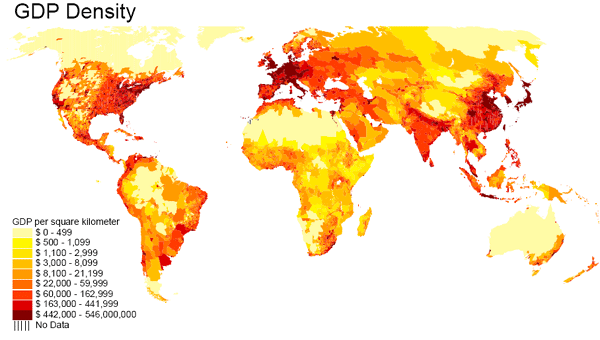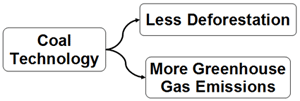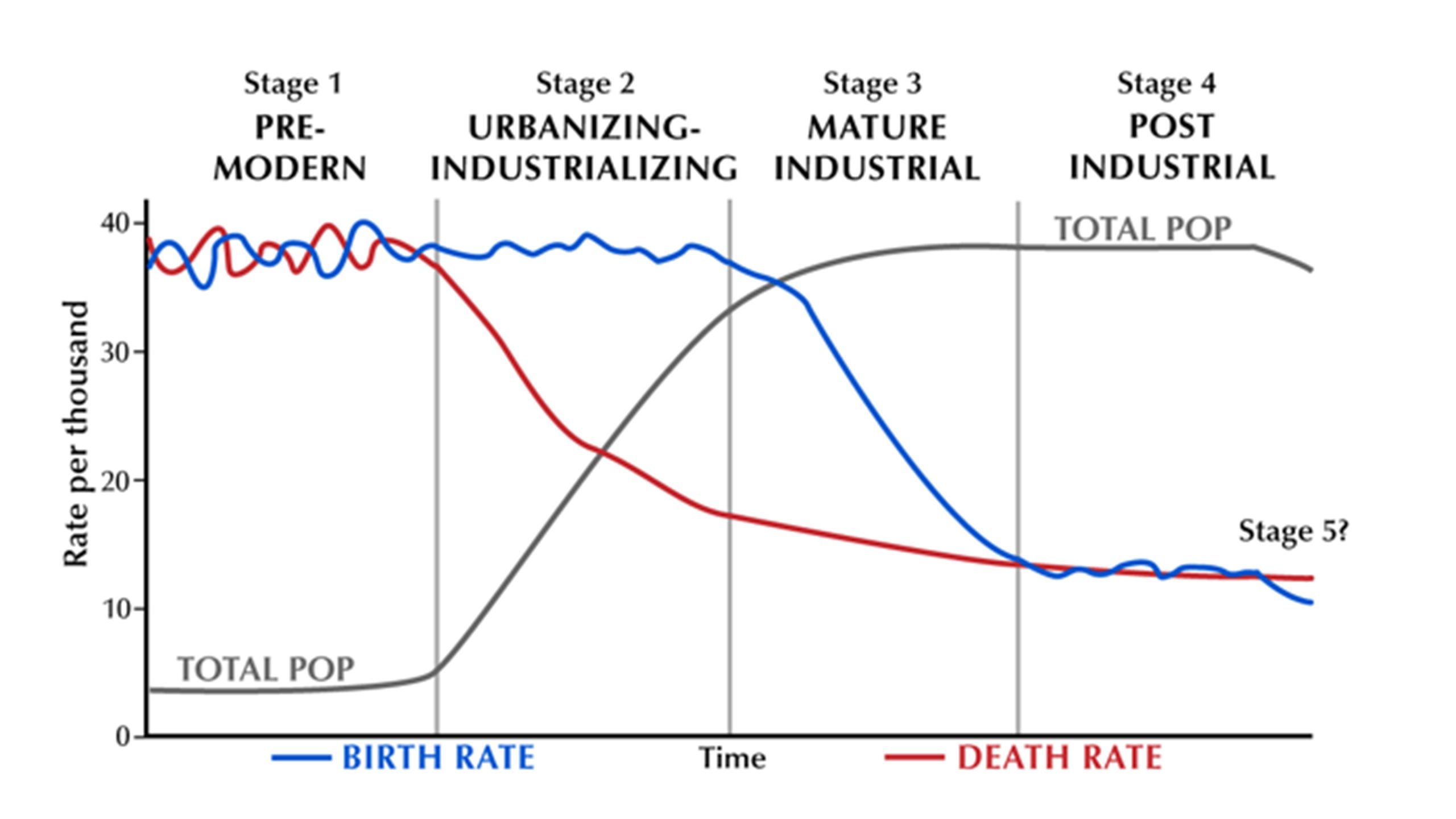13 Population, Affluence, and Technology
Population, Affluence, and Technology
Now that we’ve covered resilience, let’s return to the question of humans and carrying capacity. There is no doubt that human impacts on our environments are often very strong – frequently strong enough to exceed the systems’ resilience. Here, we’re going to explore the relationship between human population, resource consumption, and the impact on ecosystems.
The IPAT Equation: I = P x A x T
A classic attempt to explain the relationship between a human population and its impact on the environment is the IPAT equation. The equation maintains that impacts on ecosystems (I) are the product of the population size (P), affluence (A), and technology (T) of the human population in question. This equation was developed by biologist Paul Ehrlich and environmental scientist John Holdren in 1971, and you might notice that the concept is very similar to the notion of carrying capacity presented earlier in this module. It is elegant in its simplicity, and compelling because it presents such an intuitive narrative. But intuitive narratives are not always the best explanation for complex problems. Remember the caution about carrying capacity: does it really apply to human populations?
Reading Assignment: “Too Many People, Too Much Consumption”
To gain a more detailed understanding of the arguments supporting the IPAT equation, please read the article:
“Too Many People, Too Much Consumption” by Paul and Anne Ehrlich.
The Ehrlichs are among those who initially developed the equation and remain strong supporters of it.
As you read this, consider what the equation means for human impact on the environment.
- Which areas of the world will have the largest impact?
- Also, note that the equation has been controversial. What parts of it – including how it is being used – do you agree or disagree with? Why?
Ehrlich and other IPAT supporters might attempt to explain the geographic distribution of the PAT side of the equation by looking at a map of GDP (gross domestic product) density:

The map shows where economic activity is concentrated. This might be a reasonable approximation for population times affluence, though it does not factor in technology. GDP is an important statistic, but it is important to remember that it is a measure of gross economic production and not a measure of national wellbeing. One can have a high GDP and still not be well-off, for example, if the population is overworked and/or underpaid, or if the environment suffers excessively. High GDP could also mean more sustainable consumption, energy-saving and recycling technologies, and better environmental regulations. Finally, note that this is a (rough) map of some of the potential drivers of environmental impacts. It is not a map of the impacts themselves. While the environmental impacts may be driven by human activities in these regions, the impacts often occur in different places, due to the globalized nature of both human and environmental systems. For example, economic activity in one place can cause the extraction of resources in other places, or cause pollution which spread to other places.
Different Perspectives on IPAT
The IPAT equation and other environmental explanations based on population and resource scarcity became very popular in the 1970’s with the birth of the modern environmental movement, and they have often dominated environmental activism and regulation since that time. But the ideas are actually much older than Paul Ehrlich. These arguments originated in late 18th Century England with the work of cleric and scholar Thomas Robert Malthus. In his 1798 book An Essay on the Principle of Population, Malthus argued that human population growth is exponential while natural resources (particularly food) are fixed, and their availability can only grow linearly. Thus, he argued that unless the human population was regulated in some way, the population would surpass resource availability, leading to famine, disease, and population collapse (a moment dubbed the ‘Malthusian catastrophe.’ see figure 2.8 below).

Straightforward though this may seem, Malthus placed most of the blame for human population problems squarely on the shoulders of the poor and people from less developed nations, finding fault with their ignorance and lack of moral discipline. You may think that this is a rather ugly position to take, and you are not alone. Malthusian arguments had lost prominence until the middle of the 20th Century when a new group of scholars took up the mantel of unchecked population and resource scarcity. These thinkers are known as neomalthusians because their theories are an update to the work of Malthus. The main difference in neomalthusian explanations is the acknowledgment that affluence and technology influence consumption and resource supply problems (and thus environmental impact) as well as total population. In other words, richer nations are also part of the problem – hence the IPAT equation. However, the basic premise still hinges on the notion of overpopulation and resource scarcity. Paul Ehrlich is perhaps the best known and most vocal of the neomalthusian thinkers, and his work and activism have contributed to the dominant position that neomalthusian arguments have in environmental and sustainability circles.
As mentioned earlier, these arguments are compelling, and in absolute terms they are correct. The Earth cannot support an infinite number of humans consuming an infinite number of resources. But neomalthusian arguments are based on a number of assumptions that might be problematic. First, they assume that human population growth is generally exponential. As we will discuss later on, this has not always been, nor is it now, true. Secondly, neomalthusians assume that natural resources are essentially fixed, which is why supply will eventually not keep up with demand. The truth, as you surely know, is much more complicated than that. Technology has played a crucial role in expanding resource availability in ways that may not be adequately considered in IPAT. Lastly, the neomalthusian argument assumes that growing affluence necessarily increases consumption and environmental impact. This is certainly true in some cases, like meat consumption, but not so in others, like renewable energy. Ehrlich and his neomalthusian colleagues have many critics, and we will now read a few of their arguments. As you read these articles, keep in mind our overarching question, does the carrying capacity concept really apply to human populations?
Reading Assignment: part of “The Doomslayer”
Please read part of the article:
“The Doomslayer” by Ed Regis, which was published in Wired Magazine
Read the text beginning “Still, that was a mere flash in the pan…” and stop at the paragraph beginning “A more perfect resolution of the Ehrlich-Simon debate could not be imagined…”
Consider the following. What are Simon’s views on the IPAT equation and how do they compare to Ehrlich’s?
Simon is essentially arguing that throughout history technological advances have made it so that natural resource and food production have more than kept up with population growth and demand. He also suggests that human impact on the environment is not as negative as some have claimed. These are important aspects of the IPAT equation: if more population, affluence, and technology do not bring resource scarcity and greater environmental impact, then the equation does not hold. Simon won his bet with Ehrlich (as described in the Wired Magazine reading), so there must be some substance to Simon’s ideas. He was certainly correct that in virtually all cases, natural resources and commodities like food are more plentiful now than in the past, and supply has certainly kept up with demand. What Simon does not mention, and what Ehrlich and his colleagues failed to realize, is that commodity prices are not merely a reflection of overall supply or scarcity. Consider the price of oil. Oil prices in 2016 reached record lows even though oil is absolutely a finite resource. Much of this is due to hydraulic fracturing technologies, which have temporarily increased supply, but at a potentially great environmental price. Thus, when looking at these debates, it is important for us to be able to analyze the evidence and the arguments for ourselves, so that we can avoid making the same mistakes as others may be making.
Reading Assignment: part of “What Are You Optimistic About? Why?”
Please read the following article by Ray Kurzweil:
What Are You Optimistic About? Why? by Ray Kurzweil.
Consider what Kurzweil’s views on the IPAT equation might be, and how they compare to Ehrlich’s and Simon’s.
Kurzweil is a famous inventor and futurist. He argues that future technologies will be able to address our environmental concerns. This type of solution to environmental problems is called a technofix, and it raises an important point about the “T” in the IPAT equation. While some technology certainly does increase environmental impact, other technology decreases it. For example, coal power technology generally increases our greenhouse gas emissions, whereas solar power technology generally decreases emissions. To be more specific, some coal technology can decrease emissions, if it produces energy from coal more efficiently than other coal technology. Also, coal technology can reduce other environmental impacts, such as deforestation, if coal is used for energy instead of wood or charcoal. So, technology impacts the environment in many ways – which is a good reason for us to maintain a systems perspective.

Kurzweil’s fervent belief in technology also relates to the “A” (affluence) component of IPAT. Alternative energy technologies and most other technological research and development happens in the richest nations. And wealthy countries are almost always the first to adopt these new technologies. This links Kurzweil’s viewpoint with another prominent counterpoint to IPAT and the neomalthusian approach: the Environmental Kuznets Curve (Figure 2.10). Both Kuznets and the neomalthusian models assert that consumption increases with affluence, but the Kuznets model argues that the environmental impact of that increased consumption eventually levels off and decreases as more affluent populations adopt more sustainable consumption habits and technologies.

The arguments of Kuznets and Kurzweil are supported by numerous examples from wealthier and technologically advanced nations and cities around the world. A geographic approach to human-environment issues raises an important challenge: are these affluent populations really decreasing their environmental impacts, or are they just moving the impacts someplace else? Consider the example of forest cover. The United States and many western European countries have experienced a significant expansion of forest cover over the last 50-100 years. Kurzweil or the Kuznets model might argue that this is because the populations have developed resource saving technologies or more responsible consumption habits. To a certain extent, this is probably true. But over the same period that the US and Europe watched their forests grow back, forests in the tropics, particularly in Brazil and Indonesia, experienced devastating losses. This is partly because richer nations began sourcing some of their food and timber products from other places rather than producing them at home. The web of resource use is complex and difficult to unravel. One of the goals of this course is to give you the tools to think critically and geographically about human-environment interactions.
Kurzweil is arguing that technology can and will be developed so as to resolve some of our major environmental concerns. Is this true? Right now, it is very difficult to say. Technology is notoriously difficult to predict. While there probably will be at least some technological advances that decrease our environmental impact, we simply don’t know how successful this will be.
Reading Assignment: “Taking Population Out of the Equation”
Please read the article:
“Taking Population Out of the Equation” by H. Patricia Hynes, published by the Committee on Women, Population, and the Environment.
Consider what Hynes’s views on the IPAT equation are, and how they compare to the others we have seen.
Hynes is arguing that the IPAT equation has inappropriately focused attention on the world’s poor as causes of environmental problems. Hynes emphasizes a distinction between the environmental impacts of consumption that is necessary for survival and of consumption that is a luxury. Perhaps we should be more critical of luxury consumption. But what is luxury consumption, anyway? Hynes suggests things like golf courses and speedboats, but there is a big difference between necessary consumption and speedboats. The truth is that even average consumption in the US consumes vastly more resources than in even relatively well-off countries. You can calculate your ecological footprint , and you might be surprised what you find. In most cases, the American lifestyle would only be sustainable for a global population that is about 1/4 the current total. So is “P” or “A” the main problem? You be the judge. Hynes also emphasizes the environmental impacts of military activity. It is true that the military has a large environmental impact. For example, the United States military consumes more energy than any other organization in the world.
Finally, Hynes emphasizes the gender issues surrounding population, such as the ability of women to choose when to become pregnant. An alternative model to malthusian population growth is the demographic transition model (figure 2.11). The transition model argues that as populations become more industrialized, more educated, and more affluent, fertility and death rates decline significantly. In the long-term, this leads to a stabilization and eventual decrease in total population. As Hynes would point out, the developments that lead to the demographic transition usually usher in more rights for women, including access to effective family planning. We’ve seen this transition in many of the world’s countries, and fertility rates have been in decline in virtually all areas of the world. You can explore the rates by country. Notice that in many countries, the fertility rate is around 2.5, and in most industrialized countries like the US, it is well below 2. Many demographers consider a fertility rate of 2.5 to be stable since not all children will survive to reproduce. Rates of 2.5 or less are considered a long-run contraction of a population. This is yet another reason why it is so difficult to apply the carrying capacity concept to humans.

Figure 2.11 The demographic transition model. The question mark after stage 5 indicates that human society has not developed enough to give conclusive evidence of the later stage trend.
The Takeaway
As you have now read, there are many different viewpoints on the impact of humans on their environments. Malthus and his modern proponents like Ehrlich have made many dire predictions, none of which have come true. Does that mean that human population has nothing to do with human impacts on the environment? Of course not. What it does mean is that population is far from the whole story and that technology and human adaptation are also incredibly important. The Demographic Transition model suggests that the global population will eventually stabilize, or even contract. Does that mean that economic development and equal rights are the checks to population growth that Malthus called for? Perhaps. One thing we can say for sure is that these issues are far too complex for any one theory or approach to be completely correct. Keep your critical eyes open as we continue through the course!

